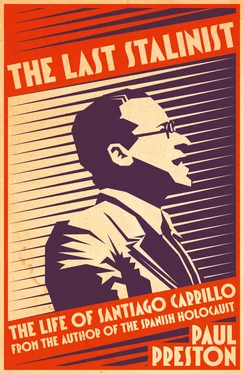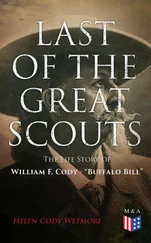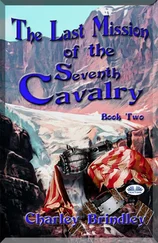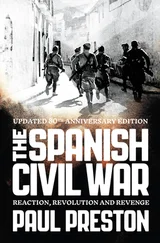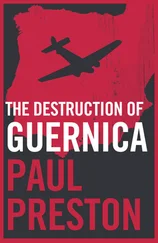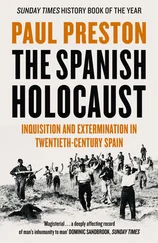Santiago was soon publishing regularly in Renovación , the weekly news-sheet of the FJS. This brought him into frequent contact with his almost exact contemporary, the famous intellectual prodigy Hildegart Rodríguez, who as a teenager was already giving lectures and writing articles on sexual politics and eugenics. She spoke six languages by the age of eight and would have a law degree at the age of seventeen. Just as she was rising to prominence within the Socialist Youth, she was shot dead by her mother, Aurora, jealous of Hildegart’s growing independence.
In early 1930, the editor of El Socialista , Andrés Saborit, offered Santiago the chance to leave the machinery of the printing works and work full time in the paper’s editorial offices. It was a promotion that suggested the hands of his father and Don Paco. He started off modestly enough, cutting and pasting agency items and then writing headlines for them. However, he was soon a cub journalist and given the town-hall beat. 4
The end of January 1930 saw the departure of the military dictator General Miguel Primo de Rivera. Between then and the establishment of the Second Republic on 14 April 1931, there was intense ferment within the Socialist movement. Certainly, there were as yet few signs of the radicalization that would develop after 1933 and catapult Santiago Carrillo into prominence on the left. The issues in those early days of the Republic revolved around the validity and value of Socialist collaboration with government. In the late 1920s, just as Santiago Carrillo was becoming involved in the Socialist Youth, there were basically three factions within both the Unión General de Trabajadores and the Socialist Party. The most moderate of the three was the group led by the academic Julián Besteiro, president since 1926 of both the party and the union and Professor of Logic at the University of Madrid. 5In the centre, at this stage the most realistic although paradoxically, in the context of the time, the most radical, was the group associated with Indalecio Prieto, the owner of the influential Bilbao newspaper El Liberal . 6The third, and the one to which Carrillo’s father Wenceslao was linked, was that of Largo Caballero, who was vice-president of the PSOE and secretary general of the UGT. 7Given his junior position on the editorial staff of El Socialista , which brought him into daily contact with Besteiro’s closest collaborator, Andrés Saborit, and given his links to Largo Caballero via his father, Santiago Carrillo found it easy to follow the internal polemics even if, to protect his job, he did not yet publicly take sides.
Although extremely conservative, Besteiro seemed to be the most extremist of the three leaders because of his rigid adherence to Marxist theory. The Spanish Socialist movement was essentially reformist and had, with the exception of Besteiro, little tradition of theoretical Marxism. In that sense, it was true to its late nineteenth-century origins among the working-class aristocracy of Madrid printers. Its founder, the austere Pablo Iglesias Posse, was always more concerned with cleaning up politics than with the class struggle. Julián Besteiro, his eventual successor as party leader, also felt that a highly moral political isolationism was the only viable option in the corrupt political system of the constitutional monarchy. In contrast, and altogether more realistically, Indalecio Prieto, who was unusual in that he did not have a trade union behind him, believed that the Socialist movement should do whatever was necessary to defend workers’ interests. His experiences in Bilbao politics had convinced him of the prior need for the establishment of liberal democracy. His early electoral alliances with local middle-class Republicans there led to him advocating a Republican–Socialist coalition as a step to gaining power. 8This had brought him into conflict with Largo Caballero, who distrusted bourgeois politics and believed that the proper role of the workers’ movement was strike action. The lifelong hostility of Largo Caballero towards Prieto would eventually be assumed by Santiago Carrillo and, from 1934, become part of his political make-up.
In fact, the underlying conflict between Prieto and Largo Caballero had been of little consequence before 1914. That was largely because in the two decades before the boom prompted by the Great War, prices and wages remained relatively stable in Spain – albeit they were among the highest prices and lowest wages in Europe. As a result, there was little meaningful debate in the Socialist Party over whether to attain power by electoral means or by revolutionary strike action. In 1914, those circumstances began to change. As a non-belligerent, Spain was able to supply food, uniforms, military equipment and shipping to both sides. A frenetic and vertiginous industrial boom accompanied by a fierce inflation reached its peak in 1916. In response to a dramatic deterioration of social conditions, the PSOE and the UGT took part in a national general strike in mid-August 1917. Even then, the maximum ambitions of the Socialists were anything but revolutionary, concerned rather to put an end to political corruption and government inability to deal with inflation. The strike was aimed at supporting a broad-based movement for the establishment of a provisional government that would hold elections for a constituent Cortes to decide on the future form of state. Despite its pacific character, the strike that broke out on 10 August 1917 was easily crushed by savage military repression in Asturias and the Basque Country, two of the Socialists’ three major strongholds – the third being Madrid. In Asturias, the home province of the Carrillo family, the Military Governor General Ricardo Burguete y Lana declared martial law on 13 August. He accused the strike organizers of being the paid agents of foreign powers. Announcing that he would hunt down the strikers ‘like wild beasts’, he sent columns of regular troops and Civil Guards into the mining valleys where they unleashed an orgy of rape, looting, beatings and torture. With 80 dead, 150 wounded and 2,000 arrested, the failure of the strike was guaranteed. 9Manuel Llaneza, the moderate leader of the Asturian mineworkers’ union, referring to the brutality of the Spanish colonial army in Morocco, wrote at the time of the ‘African hatred’ during an action in which one of Burguete’s columns was under the command of the young Major Francisco Franco. 10As a senior trade unionist who took part in the strike and had experienced the severity of the consequent repression in Asturias, Wenceslao Carrillo was notable thereafter for his caution in any decision that could lead the Socialist movement into perilous conflict with the state apparatus.
The four-man national strike committee was arrested in Madrid. It consisted of the PSOE vice-president, Besteiro, the UGT vice-president, Largo Caballero, Andrés Saborit, leader of the printers’ union and already editor of El Socialista , and Daniel Anguiano, secretary general of the Railway Workers’ Union (Sindicato Ferroviario Nacional). Very nearly condemned to summary execution, all four were finally sentenced to life imprisonment and spent several months in jail. After a nationwide amnesty campaign, they were freed as a result of being elected to the Cortes in the general elections of 24 February 1918. The entire experience was to have a dramatic effect on the subsequent trajectories of all four. In general, the Socialist leadership, particularly the UGT bureaucracy, was traumatized, seeing the movement’s role in 1917 as senseless adventurism. Largo Caballero, like Wenceslao Carrillo, was more concerned with the immediate material welfare of the UGT than with possible future revolutionary goals. He was determined never again to risk existing legislative gains and the movement’s property in a direct confrontation with the state. Both Besteiro and Saborit also became progressively less radical. In different ways, all three perceived the futility of Spain’s weak Socialist movement undertaking a frontal assault on the state. Anguiano, in contrast, moved to more radical positions and was eventually to be one of the founders of the Communist Party.
Читать дальше
